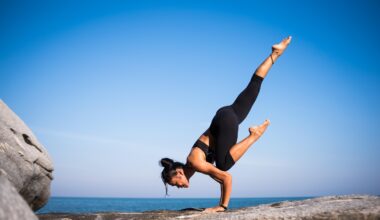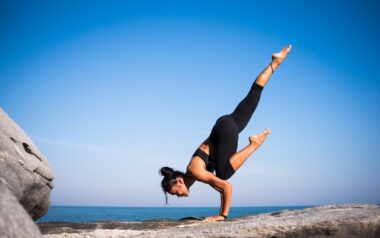The Importance of Flexibility and Mobility for Triathletes
Flexibility and mobility are critical components in the training regimen of any triathlete. Triathletes engage in three distinct disciplines: swimming, cycling, and running, making their bodies susceptible to tightness and injury. Maintaining flexibility helps improve the range of motion in joints and muscles, allowing for optimal performance across all three sports. A flexible athlete can make smoother transitions between disciplines, reducing the physical stress involved in changing activities. Moreover, good mobility enables better body control while both training and competing, which further enhances efficiency. Implementing a regular flexibility routine can also aid in recovery, alleviating muscle soreness and tension post training sessions. Stretching and mobility exercises help keep muscles pliable and less prone to injury, which is essential during high-intensity workouts. Incorporation of dynamic stretches before training and static stretches post-workout form a balanced approach towards mobility. Additionally, focusing on specific muscle groups utilized in triathlon can lead to even greater benefits. Triathletes who prioritize flexibility are likely to outperform peers who neglect this crucial aspect of physical training. Thus, adopting a strategic flexibility program can yield significant competitive advantages.
Types of Flexibility Training
To optimize performance, triathletes should incorporate various forms of flexibility training into their routine. Dynamic stretching, which involves movement-based stretches, is ideal as a warm-up before workouts. This form helps to prepare the muscles for the demands of training and enhances overall performance. Another beneficial technique is static stretching, typically performed after exercise. Static stretches involve holding a position for a set duration, which can aid in lengthening muscle fibers and improving overall flexibility. Additionally, athletes might consider the benefits of proprioceptive neuromuscular facilitation (PNF) stretching; this method combines static stretching with isometric contraction to promote greater flexibility gains. Incorporating yoga into a triathlete’s regimen also provides improved flexibility and mental focus. It combines breath control with stretches, enhancing both physical and psychological elements crucial for competition. Furthermore, foam rolling is an effective self-myofascial release technique aiding muscle recovery and flexibility. Each type serves a unique purpose and benefits triathletes differently. Embracing a blend of flexibility types can create a rounded approach that prepares the body for the intense demands of triathlon racing, leading to peak performance when it matters most.
Understanding the muscle groups used in triathlon disciplines is essential for targeted flexibility training. Swimming demands flexibility in the shoulders, hips, and back to promote an effective stroke and streamline body position. Cyclists benefit from hip flexor and hamstring mobility, allowing for a more powerful pedal stroke while maintaining comfort throughout long rides. Runners require ankle and lower leg flexibility to achieve optimal stride length and prevent injuries. Each sport features different movement patterns requiring specific focus areas during training. For this reason, triathletes should customize their flexibility routines to address the unique demands of their preferred disciplines. A tailored approach maximizes the benefits experienced during cross-training and competition. Additionally, incorporating stretches that engage multiple muscle groups can improve functional movement patterns and help to prevent potential injuries. Flexibility training should not be seen as an add-on but rather an integral component of a triathlete’s preparation. Over time, triathletes will develop more effective training sessions and race strategies. Continuous improvement in flexibility and mobility can lead to long-term success, enhancing an athlete’s overall experience as they navigate the demands of triathlon competition.
Incorporating flexibility and mobility assessments into training plans can help triathletes track their progress. Regular evaluations can identify weaknesses and areas needing improvement over time. Athletes should collaborate with coaches or physiotherapists who can guide them effectively through assessment techniques. These assessments could include simple range of motion tests, stretch analysis, and monitoring overall body alignment. By identifying specific limitations, triathletes can tailor their training regimens to address potential vulnerabilities. The advantage is the proactive ability to prevent injuries before they arise, keeping athletes in peak physical condition. Setting measurable flexibility goals can serve as motivation and serve to gauge progress over months of training. Tracking improvements encourages commitment to flexibility routines and enables athletes to celebrate small victories, keeping frustration low. As flexibility and mobility increase, athletes often notice easier transitions during workouts and competitions. Fitness professionals can help triathletes implement education-focused plans, making efforts to improve mobility clear and accessible. In doing so, triathletes become informed about their bodies and the significance of flexibility, enhancing their perception of training and leading to long-term dedication.
Nutrition plays a vital role in supporting flexibility and mobility for triathletes. Consuming a balanced diet rich in essential vitamins and minerals can contribute to muscle recovery and reduce stiffness in joints. Nutrients such as magnesium, omega-3 fatty acids, and vitamins C and E can help to support overall joint health. Foods rich in antioxidants can also assist in combating inflammation caused by intense training and competition. Hydration is equally important; without proper hydration, muscles can become tight and less responsive, impairing flexibility. Triathletes should prioritize adequate water and electrolyte intake to keep their bodies functioning optimally. Including anti-inflammatory foods such as berries, fatty fish, and leafy greens in their diet can enhance recovery processes while promoting increased mobility. Meal timing is essential; consuming protein and carbohydrate-rich snacks after workouts can aid in muscle recovery and flexibility improvement. Triathletes are advised to monitor their dietary habits closely and adapt their nutrition to suit their individual needs. Emphasizing the role of nutrition in promoting flexibility encourages athletes to adopt healthier eating habits, benefiting their overall performance and recovery efforts leading into competitions.
Cross-training can supplement flexibility and mobility efforts for triathletes by providing variation in workouts. Engaging in activities such as Pilates or yoga not only enhances flexibility but also addresses muscular imbalances that can occur due to repetitive movements in triathlon training. These cross-training formats encourage core strength, balance, and stability—all crucial for optimal performance across disciplines. By embracing a mix of workouts, athletes expose themselves to different resistance and movement patterns, improving their overall physical conditioning. Cycling, swimming, and running are high-intensity activities requiring joint stability; dedicating time to lower-impact cross-training options can alleviate stress on the body during high-volume training weeks. Integrating mobility-focused exercises within cross-training sessions can also serve as a recovery method. This strategy helps enhance joint health while improving flexibility without overexerting the primary triathlon-specific muscles. Such workouts can be enjoyable and offer a mental break from standard routine, reducing the risk of burnout. Continuously exploring various training methods keeps athletes engaged and motivated, ultimately optimizing their flexibility and mobility for competitive endurance sports environments.
Regular flexibility and mobility training has lasting impacts on a triathlete’s performance both during training and competition. Athletes who consistently incorporate stretching and mobility exercises into their routines are likely to experience decreased injury rates and enhanced recovery. A strong flexibility foundation supports improved biomechanics, leading to a more efficient performance during race events. Furthermore, flexible muscles and joints can better withstand the rigors of competing in a triathlon, allowing triathletes to push their limits without fear of injury. Improved flexibility can also lead to enhanced mental focus and relaxation, essential factors in high-pressure situations such as race day. Triathletes often face significant stress during training and competitions; developing a comprehensive program addressing mobility can help foster mental resilience. This can significantly aid their overall experience when training for triathlons. As athletes note these noticeable changes, they may find the motivation to maintain a dedication towards flexibility and mobility. Ultimately, the benefits extend beyond individual performance, impacting overall well-being and fitness resilience, shaping a triathlete’s journey as they engage in this challenging yet rewarding sport.





